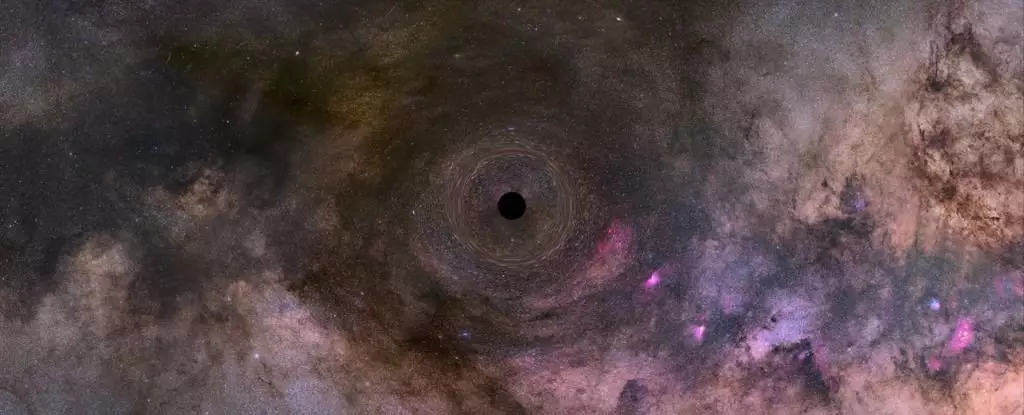In a groundbreaking revelation, astronomers have confirmed the existence of a truly solitary black hole venturing through the cosmos, a phenomenon both rare and mesmerizing. This cosmic entity, with a mass approximately 7.15 times that of our Sun, resides around 4,958 light-years from Earth. This particular black hole is notable not just for its mass and position but for its remarkable and unprecedented solitude; unlike its usual counterparts that often exist in binary systems with stars, this black hole appears to be alone in its voyage across the universe. The scientific community has long speculated about the existence of such solitary giants, but this discovery lends concrete support to the theory that they do indeed roam our galaxy, hidden from the naked eye.
The Mechanism of Discovery: Gravitational Microlensing
The key to identifying this elusive black hole was a phenomenon known as gravitational microlensing. This method illustrates how massive objects, such as black holes, can manipulate light from distant stars due to their immense gravitational pull. As the black hole passed in front of a background star, its gravitational field distorted the light, amplifying it and temporarily altering the star’s apparent position in the sky. This allowed astronomers to infer the black hole’s existence despite its lack of emitted light—a distinctive characteristic that separates it from typical celestial bodies.
The analysis was not straightforward, though. Initial observations of the object began in 2011 during extensive surveys like the Optical Gravitational Lensing Experiment (OGLE) and the Microlensing Observations in Astrophysics (MOA). Collectively, these efforts were designed to find such extraordinary occurrences, yet they had to contend with a number of challenges along the way.
A Journey of Science and Collaboration
The journey towards confirming this black hole’s identity involved significant collaboration and technological prowess. Over six years, the Hubble Space Telescope captured eight observations of the gravitational effects on the light from the background star, while 16 different telescopes contributed photometry data to the cause. Furthermore, spectroscopy observations helped to precisely gauge the extent of the light’s warping. It was a combination of diverse technological input and rigorous methodology that ultimately pointed toward the existence of a black hole.
However, in a twist, a second analysis in 2022 questioned this identification, suggesting that the object could be a neutron star instead due to a different mass estimation. This hypothesis introduced a layer of uncertainty and spurred a series of follow-up studies aimed at settling the debate. Such instances in scientific discovery highlight the importance of rigorous analysis and peer review—essential elements that help ensure the accuracy of findings in the ever-evolving field of astrophysics.
Unraveling the Cosmic Puzzle
Eventually, a concerted effort involving many of the original researchers led to a reaffirmation of the black hole’s solitary status. With additional observations extending the research timeframe to 11 years, updated photometry confirmed their initial findings. The researchers unveiled how meticulous adjustments had to be made to account for the brightness of a nearby star that obscured their observations, an obstacle that underscores the challenges faced by astronomers working to detect objects that do not shine.
The beauty of this discovery lies not only in its scientific significance, but also in its philosophical implications. This solitary black hole serves as a reminder of the mysteries that lie beyond our current understanding of the universe. While it’s an anomaly, it suggests that many such invisible beings might exist unobserved, wandering through space and evading our detection.
The Implications of Cosmic Solitude
The realization that our universe could be populated with many unseen solitary black holes raises intriguing questions about the nature of dark matter and the evolution of galaxies. If these rogue black holes are indeed as numerous as theories suggest, their interactions with visible matter could lead to phenomena that significantly impact stellar formation and cosmic structure.
Unlike typical binary black holes that can be identified through their interactions with luminous partners, these solitary masses represent a quieter but potentially more widespread aspect of cosmic life. They may influence the gravitational dynamics of their surroundings in subtle ways, reshaping thoughts on the distribution of matter across the universe.
This discovery represents another stone in the edifice of our understanding of black holes, illustrating not just their complexity but how much more there is to uncover. The cosmos remains an enigmatic and bottomless well of wonders that invites both humble inquiry and ambitious exploration.

